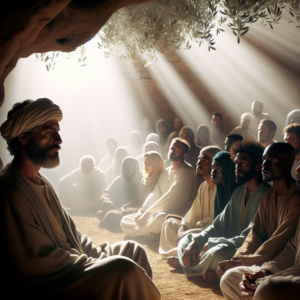Spiritual Devotional about Sacred Texts
Embracing the Wisdom of Sacred Texts: A Journey of Spiritual Enrichment
Greetings, dear readers!
Today, let’s embark on a journey through the profound and enlightening realm of sacred texts. Across the tapestry of time and cultures, these revered writings have served as beacons of wisdom, guiding souls along their spiritual journeys. Whether they capture divine revelations, recount the teachings of spiritual leaders, or impart timeless truths, sacred texts offer a wellspring of inspiration and hope.
In Christian tradition, the Bible stands as a testament of divine wisdom and guidance. As Psalm 119:105 beautifully expresses, "Your word is a lamp to my feet and a light to my path." This verse illuminates the role of sacred texts as a guiding light, steering us through the intricacies of life with insight and clarity.
However, the beauty of sacred texts is not exclusive to Christianity. Every spiritual tradition cherishes its own scriptures, each offering unique paths to understanding and connection. The Quran, the Bhagavad Gita, the Torah, and many others all brim with wisdom that transcends time and culture. Exploring these texts allows us to appreciate diverse teachings, broadening our horizons and deepening our empathy for others on different spiritual paths.
But how do we approach these sacred writings in a way that truly enriches our lives? Here are a few ways to immerse ourselves in the wisdom they offer:
-
Open Heart, Open Mind: Begin your exploration with a heart willing to learn and a mind eager to understand. Every sacred text has layers of meaning—historical, cultural, spiritual—that can enlighten and inspire.
-
Reflect and Meditate: Take the time to reflect on the passages that resonate with you. Meditation or prayerful contemplation can deepen your understanding and help integrate these insights into your daily life.
-
Seek Community and Conversation: Engaging with others in discussions about sacred texts can reveal perspectives you may not have considered. Community study groups or interfaith dialogues are excellent ways to explore together.
-
Live the Teachings: Ultimately, sacred texts are not merely to be read, but lived. Apply the principles and values you discover to your life, letting them transform your actions, thoughts, and interactions.
The wisdom found in sacred texts is boundless, limited only by our willingness to explore and embrace it. As you delve into these spiritual treasures, allow them to kindle a light within you—one that sparks joy, understanding, and a deeper connection with the Divine and with others.
In our pursuit of spiritual growth, may we remind ourselves of the words from Proverbs 3:13-14, "Blessed is the one who finds wisdom, and the one who gets understanding, for the gain from her is better than gain from silver and her profit better than gold."
May your journey with sacred texts be richly rewarding and joyfully uplifting. Here’s to the limitless discoveries that await within these pages!
With love and light,
[Your Name]
Explore and dig up answers yourself with our BGodInspired Bible Tools! Be careful – each interaction is like a new treasure hunt… you can get lost for hours 🙂
Q&A about Sacred Texts
Certainly! Here is a Q&A based on the theme of sacred texts from various religious and spiritual traditions.
Question 1:
What is the significance of the Bhagavad Gita in Hinduism?
Answer 1:
The Bhagavad Gita is a 700-verse Hindu scripture that is part of the Indian epic Mahabharata. It is a conversation between prince Arjuna and the god Krishna, who serves as his charioteer. The Gita addresses the moral and philosophical dilemmas faced by Arjuna as he prepares to go into battle. It explores key themes such as duty (dharma), righteousness, and devotion. The text is considered one of the most important spiritual classics and philosophical masterpieces in Hinduism, offering profound teachings on how to live a fulfilling and principled life.
Question 2:
In what language was the Quran originally written, and why is this significant?
Answer 2:
The Quran was originally written in Classical Arabic. This is significant because Arabic is considered the sacred language of Islam, and the Quran is regarded as the literal word of God (Allah) as revealed to the Prophet Muhammad. The text’s original language is deemed essential for preserving its divine authenticity, poetic beauty, and nuanced meanings. Many Muslims around the world learn Arabic to read and recite the Quran as it was originally revealed.
Question 3:
What are the Four Noble Truths, and which Buddhist text introduces them?
Answer 3:
The Four Noble Truths are the fundamental teachings of Buddhism and were first introduced in the Dhammacakkappavattana Sutta, which translates to "The Setting in Motion of the Wheel of Dharma." The Four Noble Truths are:
- The truth of suffering (dukkha): Life involves suffering and dissatisfaction.
- The truth of the origin of suffering (samudaya): Suffering is caused by craving and desire.
- The truth of the cessation of suffering (nirodha): It is possible to end suffering by eliminating craving.
- The truth of the path to the cessation of suffering (magga): Following the Eightfold Path can lead to liberation and enlightenment.
These truths form the foundation of Buddhist teachings and outline the path to overcoming suffering.
Question 4:
What is the Torah, and how is it used in Judaism?
Answer 4:
The Torah is the central reference of the religious Judaic tradition and consists of the first five books of the Hebrew Bible: Genesis, Exodus, Leviticus, Numbers, and Deuteronomy. These books are believed to have been given to Moses by God on Mount Sinai and include a mixture of mythology, law, and narrative history. In Judaism, the Torah is highly revered as the primary source of religious law (halakha) and guidance. It is read publicly in synagogues during Jewish worship services, particularly on the Sabbath and during Jewish festivals.
Question 5:
What is distinctive about the Guru Granth Sahib in Sikhism?
Answer 5:
The Guru Granth Sahib is the central sacred scripture of Sikhism and is considered the eternal Guru by Sikhs. Compiled by the fifth Sikh Guru, Guru Arjan Dev, it contains hymns and writings of the Sikh Gurus, as well as those of various saints from different religious backgrounds. What makes the Guru Granth Sahib distinctive is its role as the final and perpetual spiritual authority in Sikhism, replacing the line of human Gurus. The text emphasizes spiritual wisdom, the unity of God, and the importance of devotion, truth, and service. It is respected and treated with great reverence, often installed in gurdwaras (Sikh temples) worldwide.
Feel free to ask more questions or for clarification on any of these topics!


